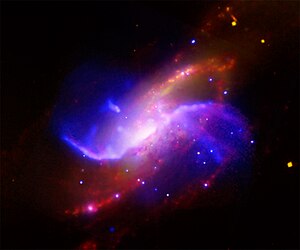Messier 106
| Galaxy Messier 106 |
|
|---|---|

|
|
| Overlay of a photograph (yellow) with images in the radio (violet), IR (red) and X-ray range (blue). | |
| AladinLite | |
| Constellation | Hunting dogs |
|
Position equinox : J2000.0 , epoch : J2000.0 |
|
| Right ascension | 12 h 18 m 57.5 s |
| declination | + 47 ° 18 ′ 14 ″ |
| Appearance | |
| Morphological type | SAB (s) bc / LINER / Sy1.9 |
| Brightness (visual) | 8.3 mag |
| Brightness (B-band) | 9.1 mag |
| Angular expansion | 18 ′, 6 × 7 ′, 2 |
| Position angle | 150 ° |
| Surface brightness | 13.5 mag / arcmin² |
| Physical data | |
| Affiliation |
Ursa Major Group , Coma Sculptor Group, Canes Venatici II Group, or Canes Venatici I Group , LGG 290 |
| Redshift | +0.001494 ± 0.000010 |
| Radial velocity | +448 ± 3 km / s |
|
Stroke distance v rad / H 0 |
(23 ± 2) x 10 6 ly (6.95 ± 0.49) Mpc |
| history | |
| discovery | Pierre Méchain |
| Discovery date | July 1781 |
| Catalog names | |
| M 106 • NGC 4258 • UGC 7353 • PGC 39600 • CGCG 244-003 • CGCG 243-067 • MCG + 08-22-104 • 2MASX J12185761 + 4718133 • VV 448 • GC 2841 • H V 43 • h 1175 • | |
Messier 106 or NGC 4258 is a bar-spiral galaxy with dimensions 18 ′, 6 × 7 ′, 2 and an apparent magnitude of 8.3 mag in the constellation Canes Venatici .
M106 is a galaxy that is assigned the type Sbp in the Hubble sequence , where the p stands for peculiar , d. H. peculiarly . Some authors also indicate the type with SABbc, i.e. between normal spiral and bar spiral . At a distance of about 23 million light years , the galaxy lies in the vicinity of several galaxy groups, as a member of which the galaxy is listed depending on the author, for example the Ursa Major group , the Coma Sculptor group , the Canes Venatici-I -Group or the Canes Venatici II group . The galaxy is about 135,000 light years in diameter.
The core of the galaxy has been active and known as a radio source since the 1950s. In 1995, Brent Tully et al. Described that the center ejects a jet that should be related to the massive central object of this galaxy discovered that same year. This central object is presumably a black hole of almost 40 million solar masses. In its environment, astrophysicists observe an emission line spectrum to which the galaxy core owes its classification as a LINER type (Low Ionization Nuclear Emission-line Region).
The two spiral arms are characterized by large numbers of young, massive stars that shine in a bluish light. The galaxy is currently going through a so-called » starburst «, in which the star formation rate is greatly increased.
The object was discovered by Pierre Méchain in July 1781 .
Detailed image of the center, Hubble Space Telescope
Far infrared image taken by the Herschel Space Telescope
Web links
- M106 at SEDS
- M106 Hubble (Lum, H-alpha, Blue) + green / red groundbased , Andre vd Hoeven, Adrian Zsilavec and Michelle Qualls / Adam Block / NOAO / AURA / NSF (9468px x 3737px)
- GALEX
- NASA: Astronomy Picture of the Day March 17, 2019
- Spektrum.de : Amateur recordings [1] [2] [3] [4]
Individual evidence
- ↑ a b c d NASA / IPAC EXTRAGALACTIC DATABASE
- ↑ a b c d e SEDS : NGC 4258
- ↑ Klaus-Peter Schröder in: Stars and Space May 2012 p. 72
- ↑ Seligman






